Starting with major scientific breakthroughs during the 1930’s, countries have developed weapons that are based on nuclear energy. The use of nuclear weapons reached its height with the outbreak of World War 1 and 2, as well as the Cold War. Tin this case, two of the world’s major superpowers, the USA and Soviet Union, threatened each other with the use of nuclear weapons, which was referred to as the Cold War. This lesson will focus on the change in the balance of power after World War II and rivalry between the new superpowers during the Cold War by exploring the Increasing tension between the Allies after the end of World War II in Europe , End of World War II in the Pacific; Atomic bombs and the beginning of the Nuclear Age, the definition of the superpowers and the meaning of ‘Cold War’, the Areas of conflict and competition between the Superpowers in the Cold War and The end of the Cold War in 1989.
Increasing tension between the Allies after the end of World War II in Europe
Although relations between the Soviet Union and the United States had been strained in the years before World War II, the U.S.-Soviet alliance of 1941–1945 was marked by a great degree of cooperation and was essential to securing the defeat of Nazi Germany. As late as 1939, it seemed highly improbable that the United States and the Soviet Union would forge an alliance. U.S.-Soviet relations had soured significantly following Stalin’s decision to sign a non-aggression pact with Nazi Germany in August of 1939. In spite of intense pressure to sever relations with the Soviet Union, Roosevelt never lost sight of the fact that Nazi Germany, not the Soviet Union, posed the greatest threat to world peace. In order to defeat that threat, Roosevelt confided that he “would hold hands with the devil” if necessary.
Finally, two devastating atomic bomb attacks against Japan by the United States, coupled with the Soviets’ decision to break their neutrality pact with Japan by invading Manchuria, finally led to the end of the war in the Pacific. Soon after the war, the alliance between the United States and the Soviet Union began to unravel as the two nations faced complex post- war decisions.
USSR (communism) vs. USA and West (capitalism)
No rivalry between different nations had greater implications for the entire world than that between the United States and the Soviet Union in the second half of the 20th century. Separated by vastly different political, economic, and social philosophies, tensions between the Soviet Union and the United States, a period historians term the Cold War, had the potential to lead to the end of the world as we know it.
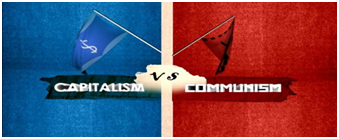 USSR (communism) vs. USA and West (capitalism).
USSR (communism) vs. USA and West (capitalism).
At various conferences, the most important of which were at Yalta and Potsdam, the three powers split Germany and its capital Berlin in two, with the eastern portion controlled by the Soviet Union and the western portion controlled jointly by the United States, the United Kingdom, and France. Additionally, the Soviet Union was given influence over the governments of several Eastern European states, where they promptly set up loyal, communist puppet regimes.
The United States and the West feared the creation of this Eastern Bloc, as Western journalists and government termed it, and the further spread of communism and/or totalitarian states in the rest of the world. U.S. foreign policy became one of containment - essentially, stopping the spread of communism wherever it could. This was in direct opposition to the Soviet Union's policy of fostering the spread of communism, especially in its Asian neighbours. The Americans then feared that the USSR/ Communist influence that already spread over Eastern Europe, would influence the democracies of western Europe.
End of World War II in the Pacific: Atomic bombs and the beginning of the Nuclear Age
When, where, why and how did World War II come to an end?
By 1943 the Allies were winning. One reason was that Allied factories were building thousands of tanks, ships and planes. In 1944, a huge Allied army crossed from Britain to liberate (free) France. Then Allied armies invaded Germany. By May 1945 the war in Europe was over.
The Pacific war went on until August 1945. There was fierce fighting on Pacific islands and big naval battles at sea. Finally, the Allies dropped atomic bombs on two Japanese cities, Hiroshima and Nagasaki. The damage was so terrible that Japan surrendered.
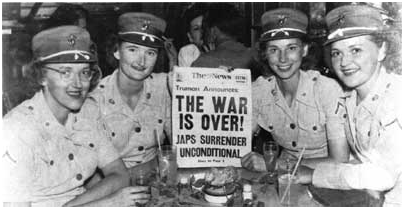 Female nurses showing a newspaper with the headline "The War is Over!".
Female nurses showing a newspaper with the headline "The War is Over!".
Britain and Commonwealth forces (Australia, Canada, India, South Africa, and New Zealand) had been opposing the Axis in North Africa since Italy’s dictator Benito Mussolini declared war on Britain and France on June 10, 1940. Once the Battle of Britain was over and the threat of an immediate German invasion of the UK removed, Britain reinforced its North Africa contingent, to protect its colonies there and particularly to protect the Suez Canal and shipping in the Mediterranean.
Allied preparations began for the invasion of Europe through Italy. The first target was the island of Sicily. Combat there included the first large-scale use of gliders and parachute troops by the Allies. Though not particularly well handled, these airborne operations provided important lessons that would be applied later on. British forces under Montgomery and U.S. troops under Patton raced to capture the city of Messina; Patton won the race, but his men arrived just hours after the last German troops had been evacuated to the Italian mainland. A new Italian government signed a secret armistice with the Allies on September 3.
Isolationist sentiment was widespread in America during the 1930’s; a reaction to the high casualties the U.S. took in the First World War while gaining little of significance for America. That sentiment died in the flames of American battleships burning at Pearl Harbor, Hawaii. The U.S., Britain and the Netherlands imposed a total embargo on Japan. Among the most critical results of the embargo was the loss of oil. Unless Japan could import the oil it needed, its navy would be drydocked within a year and its factories would shut down in about 18 months. The Imperial military leaders saw as their only hope capturing Malaya, the Netherlands East Indies, and other counties they termed "the Southern Resource Area." This course of action meant war with the United States.
World War 2 in Europe ended with the unconditional surrender of Germany in May 1945, but the exact date varies depending on which of the victorious allies you’re referring to. The German surrender was given to the Western Allies (including Britain and the U.S.) on May 8th when Adolf Hitler had committed suicide. News quickly spread about the death of Adolf Hitler and the guns fell silent. Winston Churchill the then prime minister announced Victory in Europe. In Russia, World War II ended on May 9th. In the East, the war ended when Japan surrendered unconditionally on August 14th, signing their surrender on September 2nd.
Why did the USA drop the bombs?
The United States becomes the first and only nation to use atomic weaponry during wartime when it drops an atomic bomb on the Japanese city of Hiroshima. By the time that the USA tested the first successful atomic bomb in the New Mexico desert in July 1945 to originally use on Germany, they have already been defeated, but Japan was still fighting in the war. This atomic testing marked the advent of the nuclear age.
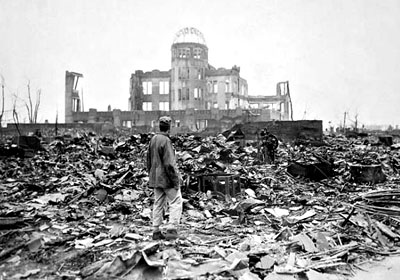 A man staring at what used to be a shopping center after the USA dropped atomic bombs on Japan. Image source
A man staring at what used to be a shopping center after the USA dropped atomic bombs on Japan. Image source
After spring 1945, with Japan in an extremely weak position, the United States was considering the following ways of bringing the long war to an end: invade the Japanese mainland in November 1945, ask the Soviet Union to join the war against Japan, assure continuation of the emperor system, or use the atomic bomb; the U.S. believed that the atomic bomb could end the war for good. Japan, did not give up so easily and the fact that Germany had surrendered did not deter Japan in anyway. Japan had two Atomic bombs dropped on the country, Hiroshima and Nagasaki on the 6th and 9th of August 1945. The Atomic bomb was a turning point in World War 2, just when everyone had thought things couldn’t get any worse; a single bomb could do more damage and kill more people than a thousand bombs could achieve. Soon after this catastrophic event Japans Imperial government consulted with Emperor to try and convince him to surrender, the emperor Hirohito agreed with the Imperial government. Hirohito then made a personal radio address announcing the decision.
On the 10th of August 1945 – Hirohito agreed in principle to surrender and it wasn’t until the 15th August 1945, Hirohito and Japan formally surrenders, ending World War 2 for the entire world.
Was it justified?
The idea that a certain action is justified or not, is subjective due to people having different backgrounds and perspectives due to different upbringings. This resulted in debates lasting decades, and depending on your own perspective on the issue, you will agree or disagree with the justification of the dropping of the bombs on Japan.
The historical context and military realities of 1945 are often forgotten in judging whether it was “necessary” for the United States to use nuclear weapons. The Japanese had been the aggressors, launching the war with a sneak attack on Pearl Harbour in 1941 and subsequently systematically and flagrantly violating various international agreements and norms by employing biological and chemical warfare, torturing and murdering prisoners of war, and brutalizing civilians and forcing them to perform slave labour and prostitution.
Some professionals said yes, while others said no. Authors that say yes argue that the atomic bomb was necessary to end the war with Japan at the earliest possible moment. By the early summer of 1945, Japanese leaders knew they could not win. But they fought on in hopes of securing better surrender terms. When the atomic bomb became available in July 1945, it appeared to be the most promising way to end the war as soon as possible and without the drawbacks of the alternatives. The bomb was necessary to accomplish Truman's primary objectives of forcing a prompt Japanese surrender and saving American lives, perhaps thousands of them.
However the above idea above can be seen as justified, others say no. Before the bomb was used, U.S. intelligence officials believed the war would likely end when two things happened: When the U.S. let Japan know their Emperor could stay on as a figurehead, and when the Soviet army attacked. The U.S. did tell Japan the Emperor could remain, and the Soviets declared war, as agreed, on August 8. But U.S. officials chose not to test whether this intelligence was correct. Instead, Hiroshima was bombed on August 6, and Nagasaki on August 9. Because of logistics, an invasion of Japan could not begin for another three months, so the U.S. could have waited to see if Japan would surrender before dropping the atomic bombs.
Definition of the superpowers and the meaning of ‘Cold War’
The concept of a superpower was a product of the Cold War and the nuclear age. Its common usage only dates from the time when the adversarial relationship of the United States and the Soviet Union became defined by their possession of nuclear arsenals that were so formidable that the two nations were set apart from any others in the world. Superpower diplomacy is thus closely related to nuclear weapons. A superpower is defined as a state that has a leading position in the international system, capable of projecting significant military power anywhere in the world. In 1944, when the term was coined, there were three superpowers: the United States, the British Empire, and the Soviet Union. Throughout the time known as the Cold War, the rivalry between the superpowers the US and the USSR, set the tenor for world politics after Great Britain fell from its place as a superpower due to the stresses of the war and numerous independence movements among its colonies. Today the USA is seen as the only remaining superpower after the fall of the Soviet Union in 1991.
The Cold War refers to the nonviolent conflict between the U.S. and the former U.S.S.R. after 1945. a In other words, it was the conflict or dispute between two groups (USA and USSR) that does not involve actual physical fighting.
Areas of conflict and competition between the Superpowers in the Cold War
Arms race
An arms race denotes a rapid increase in the quantity or quality of instruments of military power by rival states in peacetime; in this case, the rivalry between the USA and USSR after the Second World War. The build- up of arms is one of the most profound characteristics of the Cold war. The Arms race started with the creation of ‘Trinity’- the first bomb tested in New Mexico by the USA in 1945. The use of nuclear bombs was aimed at the end of the Second World War, but Germany had already surrendered. Japan was still fighting in the war, and the USA decided to use the bomb on Japan to end the war. On August 29th, 1949, the Soviet Union detonated its first atomic bomb, at the Semipalatinsk Test Site in Kazakhstan. This event ends America's monopoly of atomic weaponry and launches the Cold War. In the 1950's, The Arms Race became the focus of the Cold War. America tested the first Hydrogen (or thermo-nuclear) bomb in 1952, beating the Russians in the creation of the "Super Bomb".
 A cartoon showing the two presidents of the opposing countries involved in the Cold War. Image source
A cartoon showing the two presidents of the opposing countries involved in the Cold War. Image source
The political climate of the Cold war became more defined in January, 1954, when U.S. Secretary of State John Foster Dulles announced the policy that came to be known as "massive retaliation" -- any major Soviet attack would be met with a massive nuclear response. As a result to the challenge of "massive retaliation" came the most significant by-product of the Cold War, the Intercontinental Ballistic Missile (ICBM), which were supported with the thermo-nuclear bomb (with a much greater destructive power than the original atomic bomb), inertial guidance systems (defines the difference between weight, the influence of gravity and the impact of inertia), and powerful booster engines for multistage rockets. For more than thirty years, the ICBM has been the symbol of the United States' strategic nuclear arsenal.
In October 1961, The Soviet Union detonates a nuclear device, estimated at 58 megatons, the equivalent of more than 50 million tons of TNT, or more than all the explosives used during World War II. It is the largest nuclear weapon the world had ever seen at that time. The Tsar Bomba (King of the Bombs) is detonated after US and USSR agrees to limit nuclear testing. It is the largest nuclear device ever exploded. Having no strategic military value, Tsar is viewed as an act of intimidation by the Soviets.
Space race
The Space Race was exacerbated by events such as the construction of the Berlin Wall, the Cuban Missile Crisis and the outbreak of war n Southeast Asia. On October 4, 1957, a Soviet R-7 intercontinental ballistic missile launched Sputnik (Russian for “traveler”), the world’s first artificial satellite and the first man-made object to be placed into the Earth’s orbit, which came as a surprise to Americans. They had seen space exploration as the next frontier; a logical extension of the grand American tradition of exploration, and it was crucial not to lose too much ground to the Soviets. In 1958, the U.S. launched its own satellite, Explorer I, designed by the U.S. Army under the direction of rocket scientist Wernher von Braun. That same year, President Dwight Eisenhower signed a public order creating the National Aeronautics and Space Administration (NASA), a federal agency dedicated to space exploration.
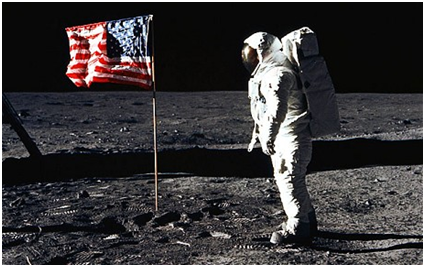 Buzz Aldrin poses for a photograph beside the U.S. flag during the Apollo 11 mission on July 20, 1969. Image source
Buzz Aldrin poses for a photograph beside the U.S. flag during the Apollo 11 mission on July 20, 1969. Image source
In 1959, the Soviet space program took another step forward with the launch of Luna 2, the first space probe to hit the moon. In April 1961, the Soviet cosmonaut Yuri Gagarin became the first person to orbit Earth, traveling in the capsule-like spacecraft Vostok 1. For the U.S. effort to send a man into space, dubbed Project Mercury, NASA engineers designed a smaller, cone-shaped capsule far lighter than Vostok, and on May 5, astronaut Alan Shepard became the first American in space (though not in orbit). The USA stated that they would be able to launch the first man in space.
By landing on the moon, the United States effectively “won” the space race that had begun with Sputnik’s launch in 1957. The American public’s attention was captivated by the space race, and the various developments by the Soviet and U.S. space programs were heavily covered in the national media. While American astronauts were depicted as heroes, Soviets were pictured as the ultimate villains, with their massive, relentless efforts to surpass America and prove the power of the communist system.
As they had agreed at Yalta and Potsdam, Germany was pided into four zones of occupation. At first relations between the forces were good as all were united in the belief that Nazism should be crushed. However, the USA, Britain and France saw quickly that Germany would have to be supported economically if communism was to be prevented. The allies wanted a strong, democratic country to become their ally, who acted as a buffer against the communist states of Eastern Europe. In contrast, Stalin wanted to weaken Germany as a punishment for the war, to help rebuild the USSR by stealing German industrial technology and to make communism seem more attractive to the Germans. The West depended upon Soviet goodwill to keep open routes to the British, French and American zones of the city.
During 1961, in an effort to stem the tide of refugees attempting to leave East Berlin, the communist government of East Germany begins building the Berlin Wall to pide East and West Berlin. Construction of the wall caused a short-term crisis in U.S.-Soviet bloc relations, and the wall itself came to symbolize the Cold War.
Throughout the 1950s and into the early 1960s, thousands of people from East Berlin crossed over into West Berlin to reunite with families and escape communist repression. To put an end to this outflow of people, all entry points in to West Berlin were blocked and the wall successfully pided the two parts of Berlin.
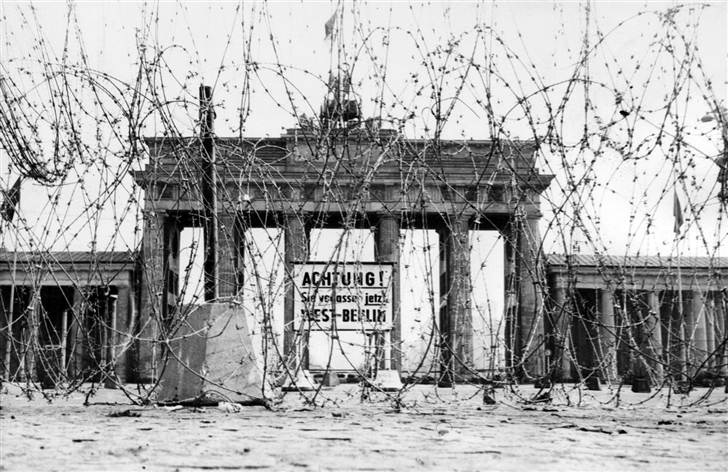 The Berlin Wall was erected to separate East and West Berlin following the wider partition of Germany after the Second World War. Image source
The Berlin Wall was erected to separate East and West Berlin following the wider partition of Germany after the Second World War. Image source
The end of the Cold War 1989
The fall of the Berlin Wall 1989
The Berlin Wall came to be the symbol of the Cold War pision in Europe. This wall symbolised the difference between the western democrats and the eastern communists and the way they thought Germany should be lead. It also symbolised the inner conflict of Germany and the pision between ‘free’ or democratic. On 9 November 1989, the communist authorities of the German Democratic Republic had announced the removal of travel restrictions to democratic West Berlin. Thousands of East Germans streamed into the West, and in the course of the night, celebrants on both sides of the wall began to tear it down.
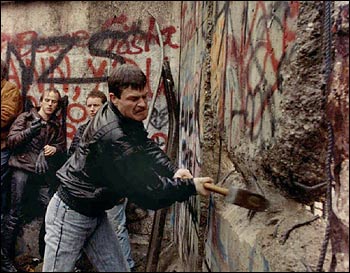 A German resident breaking down the Berlin Wall. Image source
A German resident breaking down the Berlin Wall. Image source
For two generations, the Wall was the physical representation of the Iron Curtain, and East German border guards had standing shoot-to-kill orders against those who tried to escape. But just as the Wall had come to represent the pision of Europe, its fall came to represent the end of the Cold War. Throughout the Soviet bloc, reformers assumed power and ended more than 40 years of dictatorial communist rule. The reform movement that ended communism in east central Europe began in Poland. Two years later, the 15 communist satellite states that formed art of the USSR separated and collapsed like dominoes. By 1990, former communist leaders were ousted from their positions and free elections were held.
Mikhail Gorbachev played a pivotal role in the events leading up to the wall's demise and beyond. His policies of “perestroika” - economic restructuring - and “glasnost,” or openness, which eliminated traces of Stalinist repression, like the banning of books and the omnipresent secret police, and gave new freedoms to Soviet citizens, paved the way for the dissolution of communist power in Eastern Europe and ultimately led to the collapse of the Soviet Union.
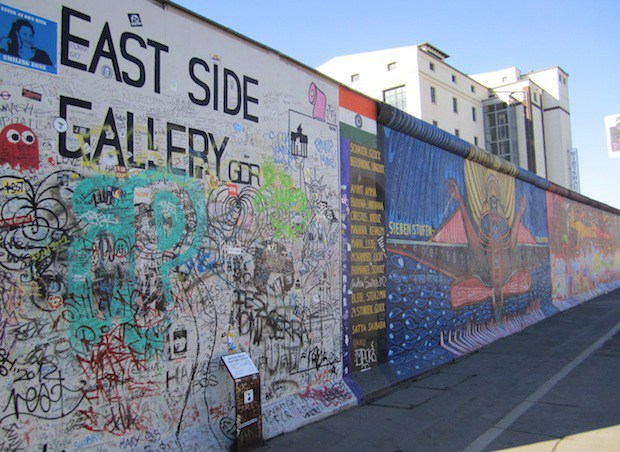 The East Side Gallery, which is a 1.3 kilometer section of the Berlin Wall. Image source
The East Side Gallery, which is a 1.3 kilometer section of the Berlin Wall. Image source
The reunification of East and West Germany was made official on October 3, 1990, almost one year after the fall of the Berlin Wall.
The fall of the Soviet Union (very briefly) 1991
The Soviet state was born in 1917. That year, the revolutionary Bolsheviks overthrew the Russian czar and established a socialist state in the territory that had once belonged to the Russian empire. In 1922, Russia proper joined its far-flung republics in the Union of Soviet Socialist Republics. The Marxist revolutionary Vladimir Lenin was the first leader of this Soviet state. After 1924, when the dictator Joseph Stalin came to power, the state exercised totalitarian control over the economy, administering all industrial activity and establishing collective farms. It also controlled every aspect of political and social life. People who argued against Stalin’s policies were arrested and sent to labour camps or executed. After Stalin’s death in 1953, Soviet leaders denounced his brutal policies but maintained the Community Party’s power, with a focus on the Cold War.
The first revolution of 1989 took place in Poland, where the non-Communist trade unionists in the Solidarity movement bargained with the Communist government for freer elections in which they enjoyed great success. This, in turn, sparked peaceful revolutions across Eastern Europe. Later that year, the Berlin Wall fell which symbolized the end of the Cold War. Frustration with the bad economy combined with Gorbachev’s hands-off approach to Soviet satellites to inspire a series of independence movements in the republics on the USSR’s fringes. One by one, the Baltic States (Estonia, Lithuania and Latvia) declared their independence from Moscow. Then, in early December, the Republic of Belarus, the Russian Federation and Ukraine broke away from the USSR and created the Commonwealth of Independent States. Weeks later, they were followed by eight of the nine remaining republics. (Georgia joined two years later.) At last, the mighty Soviet Union had fallen.
